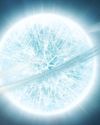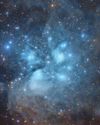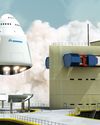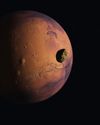MANNED MISSION TO AN ASTEROID
All About Space UK
|Issue 145
NASA plans to send manned expeditions to near-Earth asteroids in order to discover more about their formation and structure
-

Asteroids can tell us a great deal about the formation of our Solar System and could be stepping stones to the long-term colonisation of the Moon and interplanetary trips to Mars and beyond. They might well contain water and air that could be used to support deep-space manned missions, and there’s the possibility of mining them for their precious metals. They certainly have the potential to enhance human existence, yet there are at least 1,000 dangerous asteroids that pose a risk to Earth.
In April 2010, former president Barack Obama announced that NASA should send a manned mission to an asteroid by 2025. Though this target doesn’t look likely, one of NASA’s future plans is to use an unmanned spacecraft to capture a 500-tonne, seven-metre (23foot) diameter asteroid and send it into a high lunar orbit. Here, unmanned spacecraft and manned crews using Orion spacecraft could easily visit and study it in detail. An asteroid capture and return spacecraft would take about four years to reach a suitable asteroid, 90 days to deploy a large capture bag and a further two to six years to take it to the Moon.
Denne historien er fra Issue 145-utgaven av All About Space UK.
Abonner på Magzter GOLD for å få tilgang til tusenvis av kuraterte premiumhistorier og over 9000 magasiner og aviser.
Allerede abonnent? Logg på
FLERE HISTORIER FRA All About Space UK

All About Space UK
MYSTERIES OF THE UNI WHERE ARE ALL THE SPIRAL GALAXIES?
There are far fewer spiral galaxies than elliptical ones in the Supergalactic Plane, and scientists are keen to discover why
7 mins
Issue 161

All About Space UK
ZOMBIE STARS
+10 OTHER TERRIFYING SPACE OBJECTS
8 mins
Issue 161

All About Space UK
HOW TO BEAT LIGHT POLLUTION
Thought it was impossible to observe the wonders of the night sky from towns and cities? Think again. Follow our tips and tricks on successfully observing through sky glow
2 mins
Issue 161

All About Space UK
15 STUNNING STAR CLUSTERS
These beautiful stellar groupings are spattered across the cosmos
8 mins
Issue 161

All About Space UK
Eileen Collins "It was a difficult mission...we were the first to see Mir"
Having served as both the first female pilot and first female commander of NASA's Space Shuttle, Collins boosted the involvement of women in space exploration to a whole new level
9 mins
Issue 161

All About Space UK
MARS LEAKS FASTER WHEN IT'S CLOSER TO THE SUN
The Red Planet has lost enough water to space to form a global ocean hundreds of kilometres deep
2 mins
Issue 161

All About Space UK
FUTURE TECH KANKOH-MARU
This ambitious reusable spacecraft will be capable of taking 50 people to and from orbit
2 mins
Issue 161

All About Space UK
THE FINAL FRONTIER
Beyond the reach of the Sun is a fascinating region of the cosmos that were only just beginning to explore
8 mins
Issue 161

All About Space UK
A long-lost moon could explain Mars' weird shape and extreme terrain
A long-lost moon could explain why Mars is so different from the other rocky planets in the Solar System. Today Mars has two tiny moons.
2 mins
Issue 161

All About Space UK
A sprinkling of cosmic dust may have helped kick-start life on Earth
Cosmic dust may have helped kick-start life on Earth. New findings challenge a widely held assumption that this wasn't a plausible explanation.
3 mins
Issue 161
Translate
Change font size

